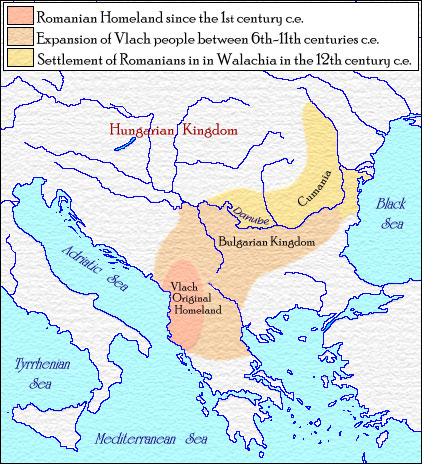0















| Thumbs Up |
| Received: 1,998 Given: 1,604 |













| Thumbs Up |
| Received: 1,998 Given: 1,604 |

I can't believe how Bosh et al came to an conclusion that there was not a significant Roman input in the Aromanians when they have high percentage of J2a and R1b, more than any other Balkan people.
Also I've checked their paper, https://onlinelibrary.wiley.com/doi/...9.2005.00251.x, and many haplotypes which are listed there are quite authentic and not found in other Balkan people, but are found in Italians...













| Thumbs Up |
| Received: 5,636 Given: 40 |

Among Hungarians is popular theory that Vlach came to Romania in 13th century from Albania, Epirus and Thessaly.














| Thumbs Up |
| Received: 1,998 Given: 1,604 |

There is a hidden history which connects the Aromanians and the Bulgarian Empire from the Medievals, for which we are not aware about...
Hopefully some day, we will know more...
As the main distinguishing features of historical Vlach ethnos should
be considered the following features:
1. Language on Romance basis.
2. The practice of pastoralism (mainly mountain one).
3. Cohabitation with other ethnic groups: Greeks, Albanians, Cumans,
Hungarians, and most of all Slavs.
The latter factor played a major role in the evolution of particular
groups of Vlachs.
On the one hand, the relations between the Vlachs and Slavs were
the result of the expansion of the Southern Slavs in the Balkans and, on
the other hand, they resulted from the expansion of Vlachs in a northerly
direction, to the northern slopes of the Carpathians, and further, to the
lowland areas of southern Poland and Ukraine of today.
Assuming that the Vlach population was already established in the
Balkans during the migration of Slavs, it should be pointed out that both
ethnic groups occupying the same land were not in conflict. Slavs, as farmers,
occupied lands in the valleys, which were suitable for them, while
Vlachs exploited mountains. Slavs, next to agriculture, also engaged in
breeding, but did not practice transhumance pastoralism, which was the
domain of the Vlachs.
For the Slavs the land and the right to its cultivation and ownership
was most important, for the Vlachs the ownership of land did not matter as
long as the mountains were common property. The element, which bound
their community together, was not the land, but family relationships, the
sense of belonging to the clan and the specific corporation of the katun.
The development of state structures, ownership and social relations
brought the evolution of relationships, which proceeded differently in different
areas.
Among the countries that we can define as Slavic, the earliest historical
sources mention the presence of Vlachs in Bulgaria. According to the
testimony of Byzantine writer Georgios Kedrenos, David, the brother of
the Bulgarian Tsar Samuel, reigning in the late 10th and 11th century, was
killed by “wandering Vlachs” travelling between Kastoria and Prespa1
.
Byzantine princess Anna Commena, who writes in the 12th century, mentions
numerous Vlachs, nomads living in Bulgaria2
. It should be noted that
Anna Comnena wrote it at a time when the Bulgarian state did not exist
for over a hundred years. Thus, it is necessary to ask, which territory in her
chronicle could be called Bulgaria? It could only be Byzantine themata of
Bulgaria, which was located in the western part of Macedonia.
The presence of numerous Vlachs in this area is confirmed during the
construction of the second Bulgarian state after the great anti-Byzantine uprising of 1185. The creators of the restored state, Asen dynasty, appealed
to the traditions of the Bulgarian state, but they were of Cuman-Vlach origin
and adopted the title of tsar of Bulgarians, Vlachs and Cumans.
In 1203–1204 the Bulgarian tsar Kaloyan wrote in letters to Pope Innocent
III that he reigns over Bulgarians and Vlachs like his ancestors, tsars
Simeon, Peter and Samuel - the first rulers of the Bulgarian state in the
10th–11th century3
. More than that, in the correspondence between the Pope
and Kaloyan of Bulgaria for the first time appeared the term “Blachia” in
the territorial meaning.
Bulgarian tsar sent to the Pope the Archbishop of Bulgaria and Vlachia,
Basil, while Innocent III in his edict of 25 February 1204 gave royal crown
to Kaloyan and established the Roman Catholic Church for the province of
Bulgaria and Blachia/Vlachia. It can be concluded that the Bulgarian state
entered the territory so densely populated by Vlachs that it could have
been named Vlachia, and that it had to have some specific administrative
framework as it was considered a province.
Additionally, chroniclers of the fourth crusade, Geoffroy de Villardhuin
and Robert de Clari, referred to the Bulgarian tsar as John of Vlachia
(Blakia)5
. One might ask where this Vlahia province was situated. Robert
de Clari wrote that it was a province belonging to the Byzantine emperor,
who rebelled against him. It was harsh and inaccessible land, which could
have been accessed only by ravines. Undoubtedly, we cannot identify this
Vlachia with the Wallachian Plain, as most recently historiography does,
because 1) it could have been accessed very easily from the south, 2) it never
belonged to Byzantine Empire. In the light of these chroniclers Vlachia
must be placed in the Byzantine themata of Bulgaria, which was located in
modern Macedonia. This province bordered on Cumania, which can be
located close to Macedonian Kumanovo. Involvement of the part of the Vlach nobility in the reconstruction of the Slavic Bulgarian state may indicate
its progressive Slavisation. Although the second Bulgarian Empire,
like other medieval states, was not a nation-state, there are indications
that some Bulgarian tsars led the Slavisation actions among the Vlachs on
purpose. Paisij of Hilandar mentions that Kaloyan of Bulgaria forced the
Vlachs to use the Slavonic language in church7
. In reality, the beginning
of this process can be associated with the establishment of the first bishopric
of Wallachia in the 11th century, subordinated to the archbishopric
in Ohrid8
. This is especially interesting since the tsar led to the union between
the Bulgarian Orthodox Church and the Roman Catholic Church,
and Vlachs, not only in Bulgaria but throughout the whole Balkans and
Central Europe, mostly professed Orthodoxy of the Slavonic Rite. This
suggests that they had become the object of Christianization even earlier,
together with the Slavs, and were administratively subordinated to the
ecclesiastical organization of the states which they inhabited.
It seems that the Bulgarian state gave the Vlachs good conditions for
the development not only within their traditional structures.
Most likely the Wallachian Plain was also a part of Bulgaria for some
period of time, though, as mentioned, it should not be identified as the
Vlachia province mentioned in the documents by Kaloyan. We do not
know exactly when the Vlachs colonized the plain, but certainly in the 13th
century the process was completed. In the middle of this century the structures
of the Vlach state appeared, namely the principalities of Seneszlau
and Litovoi, and later the principality of Wallachia10. Although all these
countries were then dependent on Hungary, there are indications that the
territory of Wallachia was previously associated with Bulgaria. The title
the princes of Wallachia is almost an exact copy of the title of the Bulgarian
tsars of the second state. The princes of Wallachia, as well as Bulgarian Asen dynasty, took the name “John” while taking the power. Also,
Wallachia state system and its entire hierarchy duplicated Bulgarian patterns
and in certain territories some similarities in the social structure can
also be seen (predominance of large land property). After 1241 these lands
were separated from Bulgaria and in the last quarter of the 13th century
they fell under the nominal authority of Hungary. The preservation of the
Bulgarian administrative system facilitated the formation of the state in
this area.
source: http://dlibra.umcs.lublin.pl/Content..._41_2016_1.pdf



| Thumbs Up |
| Received: 2 Given: 0 |

I don't think Ilona already knows this,but the thing is that the Romanians-Vlachs were shepherds with stiff staffs ,the real Balkan experts in milking ewes.
Ilona is just upset that there were too many Vlachs in the South Slavic countries,but she's wrong and I can give her a lot of real proves against Slavization,like,for example,a very often used name even today for the Romanian women,Delia,in Albanian it means young sheep.
A Romanian Delia:
https://thumbor.unica.ro/unsafe/x/sm...8/03/Delia.jpg
Even more,the capital of Romania,Bucuresti,comes from bucuros,a word found only in Albanian and Romanian,and of course,there's Arges,this is the place where the shepherds became kings of Wallachia,in Curtea de Arges or Campulung,clearly related to Albanian argesh,the word for raft.
Plus,Burebista's capital was Argedava ,on the Arges river,near Bucharest,and the Albanian word for man is burre.
https://en.m.wikipedia.org/wiki/Argedava
http://www.academia.edu/5766282/Comm..._and_Loanwords



| Thumbs Up |
| Received: 2 Given: 0 |

















| Thumbs Up |
| Received: 99 Given: 20 |

Yes I agree this is nonsense in this thread haha.
However our language is very similar to Aromanian because at one point there was a continuous area of Latin speakers and it was basically the same dialect that broke apart when you Slavs migrated south. I wonder what the subclades of J2a and R1b the south Vlachs have are. We have a lot of R1b too, but most is in the local or native clade (I and a few others in Transylvania am an exception and have the more western Italo-Celtic version)
There was also some in Daco-Romanians too, since most I have seen on 23andme score from 2 to 8% Italian on there. But it was more diluted with us. Some Aromanians have some Turk also however. They are not the same as Greeks but mixed with Greeks in the last 1000 years probablyl






















| Thumbs Up |
| Received: 5,957 Given: 7,024 |

It still depends on the region they reside in. For example, Aromanians of some Albanian regions have very high J2b2 & R1b-L23.
The Italian clade of R1b is elevated in Aromanians, though the R1b-L23 is significantly higher(common in Albanians, Romanians, Peloponnese Greeks).
J2a can be either Italian(Roman) and Hellenic, depending on clades.
This study you showed has very few samples, 30 for Albanians, 42 for Aromuns, 41 for Greeks.. Also, the haplogroups are generalized there.



| Thumbs Up |
| Received: 2 Given: 0 |

Transylvania has around 20 % E-V13 in both Cluj and Brasov(Martinez-Cruz,Dracula's DNA),while Western Wallachia has even more,three studies confirm that.
Martinez-Cruz has also proved what many of us suspected for long ,Dracula and the House of Basarab weren't Cumans but Romanians,most of the Basarab surnames are E-V13,even if all of these don't reach the Middle Ages,it is still indirect evidence,after all,even Ilona invokes clan-based relations among Vlachs.
Basarab E V-13 clusters into the old Wallachian core ,Western Wallachia(Gorj) and Southern Transylvania(Sibiu,Tara Amlasului).
https://ro.m.wikipedia.org/wiki/Țara...asRomanian.svg
http://journals.plos.org/plosone/art...e.0041803.t002
http://journals.plos.org/plosone/art...l.pone.0041803
There are currently 1 users browsing this thread. (0 members and 1 guests)
 România
România
 Kosova
Kosova
Bookmarks